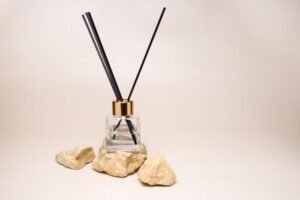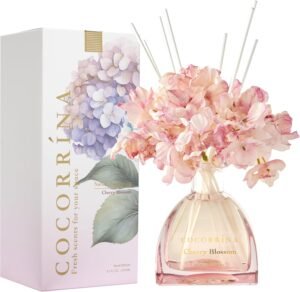Reed Diffuser Safety: Potential Disadvantages, Best Practices, and Comparisons to Candles
Thinking about freshening your home with a reed diffuser? Before you commit, you should understand the potential downsides and safety considerations that manufacturers rarely mention on the packaging.
Reed diffusers offer flameless fragrance but come with considerations including oil spill risks, pet safety concerns, and potential allergens. While generally safer than candles due to the absence of fire hazards, they require proper placement and ingredient awareness to minimize respiratory irritation and accidental exposure.
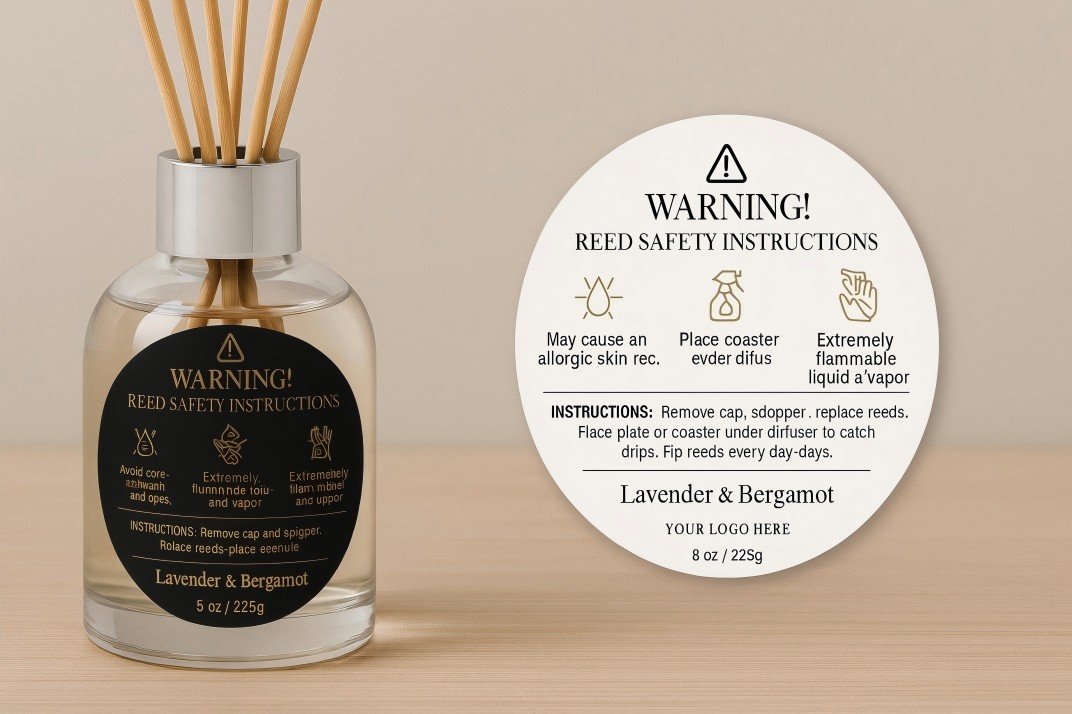
Let’s explore the complete picture of reed diffuser safety so you can make informed decisions about using these popular home fragrance products in your spaces.
What Are the Disadvantages of Reed Diffusers?
Wondering why that expensive reed diffuser might not be the perfect solution? Despite their popularity, reed diffusers come with several drawbacks that aren’t always apparent at first glance.
Reed diffusers have notable disadvantages including difficult-to-control scent intensity, potential for oil spills that damage furniture, high-quality oil expense, evaporation variability based on environment, and limited outdoor use due to wind disruption. Additionally, some may find the visual appearance of reeds less appealing than other fragrance options.

Hidden Drawbacks of Reed Diffusers
After years in the fragrance industry, I’ve identified several limitations that consumers should consider before investing in reed diffusers:
Physical and Practical Limitations
Reed diffusers present several everyday challenges that can impact their functionality:
- Fragile Components: Glass containers easily tip over, creating both breakage and oil spill hazards
- Dust Accumulation: Reeds attract dust particles that can affect scent dispersion and aesthetics
- Difficult to Transport: Once oil is added, diffusers become challenging to relocate safely
- Limited Control: Unlike electronic diffusers, there’s no way to turn off the scent when desired
- Seasonal Effectiveness: Performance varies significantly with temperature and humidity changes
Environmental and Health Considerations
| Concern | Impact | Mitigation Strategy |
|---|---|---|
| VOC Emissions | Continuous release of volatile organic compounds | Choose natural oils with lower VOC profiles |
| Allergic Reactions | Potential trigger for sensitive individuals | Test in small spaces first, monitor for reactions |
| Pet Safety | Toxic to cats and dogs if ingested | Place out of reach, use pet-safe essential oils only |
| Staining Risk | Oils can permanently damage fabrics and finishes | Use protective coasters, keep away from valuables |
| Ingredient Transparency | Limited disclosure on many commercial products | Purchase from companies with full ingredient lists |
In our manufacturing facility, I’ve witnessed the difference in quality between premium and budget diffuser bases. Many inexpensive diffusers use mineral oil or inferior carriers that don’t properly wick up the reeds, resulting in poor scent throw and disappointingly short lifespans. For optimal performance, I recommend investing in diffusers that use DPG (dipropylene glycol) or a high-quality carrier oil base specifically formulated for reed diffusion.
One often-overlooked disadvantage is the environmental impact. Traditional reed diffusers typically come in non-recyclable packaging, and the oil-soaked reeds cannot be composted or recycled. At ENO, we’ve addressed this by developing biodegradable reeds and recyclable packaging options, but these remain uncommon in the broader market.
Where Should You Not Put a Reed Diffuser?
Placed your reed diffuser in the wrong spot? Location matters significantly for both safety and performance, with several areas in your home that should be strictly avoided.
Reed diffusers should not be placed near heat sources, in direct sunlight, on unstable surfaces, near children or pets, close to food preparation areas, or on valuable/unprotected furniture. Additionally, avoid areas with strong airflow that can cause uneven diffusion and increase evaporation rates.
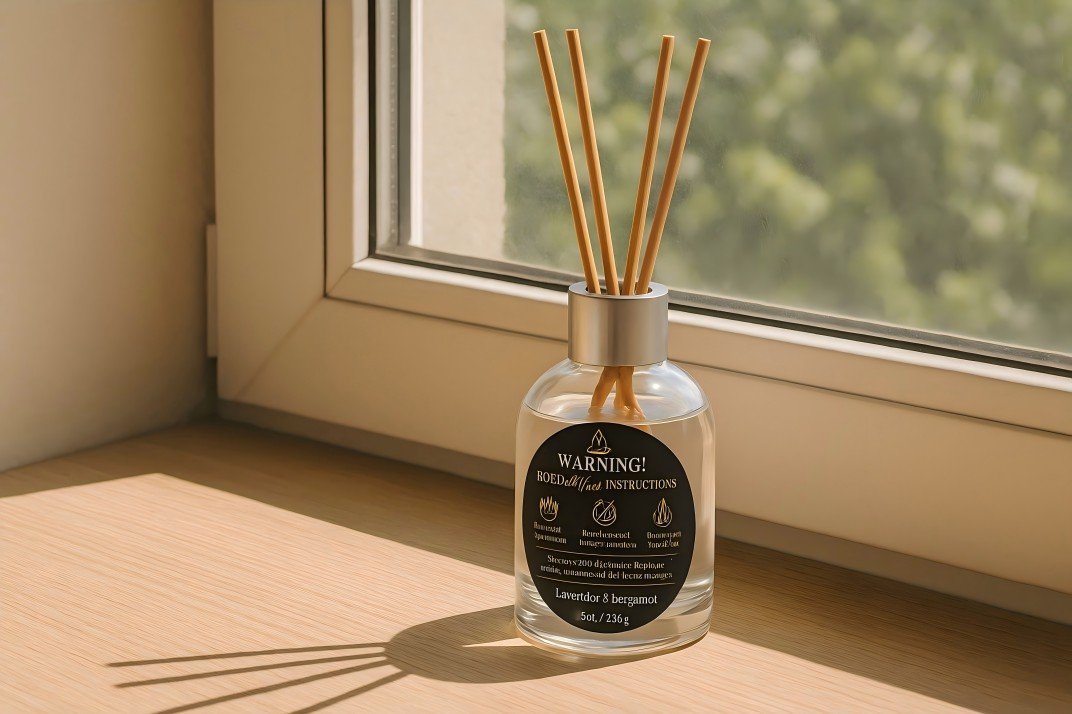
High-Risk Placement Areas to Avoid
Based on my experience with thousands of customer inquiries, these locations pose the greatest risks:
Dangerous Placement Scenarios
Understanding where not to place your diffuser can prevent accidents and performance issues:
- Near Air Vents/Fans: Causes rapid, uneven evaporation and overloads indoor air with fragrance
- Window Sills: Direct sunlight degrades oils and accelerates evaporation by up to 400%
- Near Electronics: Oil vapors can deposit on screens and sensitive components
- Bedside Tables: Too close during sleep can cause respiratory irritation and potential spills
- Low Shelves: Accessible to children and pets who may knock them over or ingest toxic oils
- Cramped Areas: Insufficient air circulation can create overpowering scent concentration
Surface Protection Guidelines
| Surface Type | Risk Level | Protection Required |
|---|---|---|
| Polished Wood | Very High | Water-resistant coaster plus absorbent base |
| Natural Stone | High | Sealed coaster to prevent staining |
| Metal | Moderate | Protective base to prevent potential corrosion |
| Glass | Low | Simple coaster to catch drips |
| Plastic | Variable | Test small area first, some plastics degrade with oil contact |
Through our product development process, I’ve learned that even small amounts of spilled diffuser oil can permanently damage certain surfaces. We’ve documented cases where just a few drops of oil penetrated wood finishes, creating permanent marks that no restoration technique could remove. This is why I always recommend using a dedicated diffuser tray or coaster designed specifically with protective barriers.
One placement mistake I frequently observe involves home offices. Many people position reed diffusers near computer equipment, not realizing that the tiny oil particles can accumulate on electronic components over time. For these environments, I recommend limiting diffuser use or switching to water-based alternatives that produce less residue.
Are Reed Diffusers Safe for the Lungs?
Concerned about what you’re actually breathing? The respiratory safety of reed diffusers depends significantly on the quality of oils used and your personal sensitivity.
Reed diffusers generally pose minimal respiratory risk for most healthy individuals when using high-quality, pure essential oils. However, synthetic fragrances and poor-quality oils can release volatile organic compounds (VOCs) that may trigger respiratory issues in sensitive individuals, including asthma exacerbation, headaches, or allergic reactions.

Understanding Respiratory Considerations
After years of researching fragrance safety, I’ve compiled these key insights on respiratory impacts:
Potential Respiratory Irritants
Certain components commonly found in diffuser oils deserve special attention:
- Synthetic Musks: Can trigger respiratory sensitivity and headaches
- Phthalates: Often used as fixatives but linked to respiratory issues
- High-Aldehyde Oils: Including cinnamon and citrus, may irritate sensitive airways
- Benzene Derivatives: Present in some synthetic fragrances, potential respiratory irritants
- Terpenes: Natural compounds that can oxidize into irritating compounds over time
Safety Variations by Population
| Population Group | Risk Level | Special Considerations |
|---|---|---|
| Healthy Adults | Generally Low | Minimal concerns with moderate use |
| Asthmatics | Moderate to High | Should test cautiously and monitor symptoms |
| Children | Moderate | Developing respiratory systems more vulnerable |
| Elderly | Variable | May have undiagnosed sensitivities |
| Pregnant Women | Moderate | Some oils contraindicated during pregnancy |
In our product testing laboratory, we conduct chamber tests to measure the exact VOC emissions from our diffuser oils under controlled conditions. What we’ve discovered is troubling: many popular commercial diffuser oils release significant levels of undisclosed synthetic compounds. This is why I strongly recommend choosing diffuser oils that provide complete ingredient transparency or that are certified by independent organizations like IFRA (International Fragrance Association).
One technical aspect rarely discussed is the difference between primary and secondary emissions. Primary emissions come directly from the oil, while secondary emissions occur when diffused oils react with ozone or other compounds in your home. These secondary reactions can create formaldehyde and ultrafine particles that pose greater respiratory concerns than the original fragrance. Using an air purifier with activated carbon can help mitigate these secondary emissions.
Can You Put Jasmine Essential Oil in a Diffuser?
Considering jasmine for its luxurious scent? This popular floral note presents unique considerations when used in reed diffusers, affecting both performance and value.
Jasmine essential oil can be used in reed diffusers, though true jasmine absolute is extremely expensive and may be too thick for effective diffusion without proper dilution. Many commercial "jasmine" diffuser oils are actually synthetic recreations or jasmine-scented fragrance oils, which perform more consistently but lack therapeutic benefits.
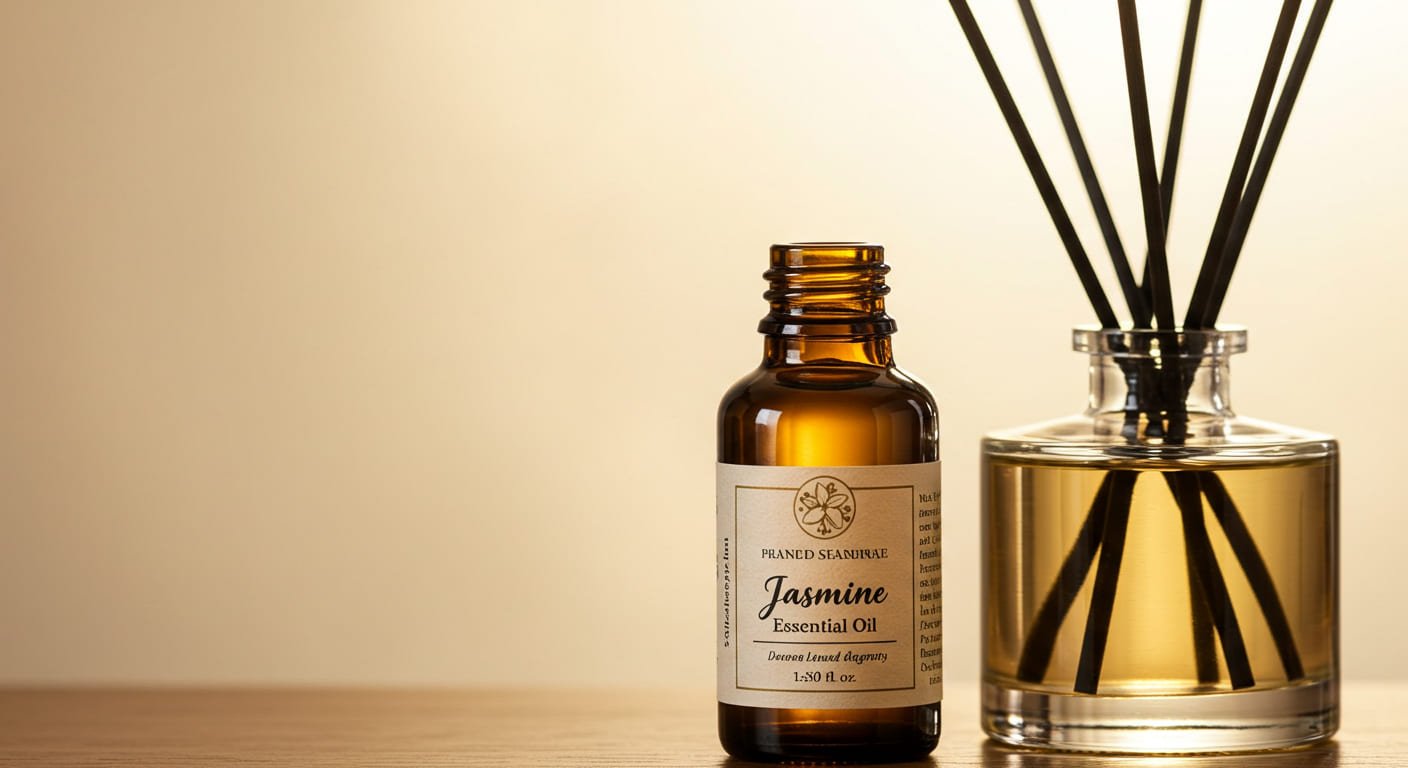
Jasmine Oil Performance in Diffusers
My extensive work with floral essential oils has revealed important considerations for jasmine in particular:
Types of Jasmine Oil and Their Diffusion Properties
Understanding the different jasmine products affects your diffusion results:
- Jasmine Absolute: The purest form, extremely thick and requires significant dilution
- Jasmine Essential Oil: Technically not a true essential oil as jasmine requires solvent extraction
- Jasmine Fragrance Oil: Synthetic recreation, thinner viscosity ideal for reed diffusion
- Jasmine-Infused Carrier Oil: Pre-diluted natural jasmine, moderate diffusion performance
Optimization Techniques for Jasmine Diffusion
| Jasmine Type | Required Dilution | Expected Performance | Price Consideration |
|---|---|---|---|
| Pure Absolute | 1-3% maximum | Slow diffusion, authentic but subtle | Very high (≈$200-400/oz) |
| Fragrance Oil | 10-30% | Consistent, stronger projection | Moderate (≈$10-30/oz) |
| Blended Oil | As packaged | Balanced performance | Variable by quality |
| CO2 Extract | 3-5% | Good diffusion with natural properties | High (≈$100-200/oz) |
In our fragrance development laboratory, I’ve tested dozens of jasmine variations to find the optimal balance between authenticity and performance. One technique I’ve found effective is creating a "hybrid" approach—using a small percentage (1-2%) of true jasmine absolute mixed with a high-quality jasmine fragrance oil. This provides both the authentic therapeutic notes of real jasmine and the consistent performance needed for reed diffusion.
For customers with respiratory sensitivities, I recommend avoiding synthetic jasmine fragrances, as they often contain artificial musks that can trigger reactions in sensitive individuals. Instead, opt for jasmine absolute diluted in jojoba oil, which provides a gentler scent profile while retaining the relaxing properties that make jasmine popular for bedroom use.
Is It Safe to Sleep in a Room With a Reed Diffuser?
Wondering if that diffuser on your nightstand might affect your sleep quality? Using reed diffusers in bedrooms presents specific considerations for overnight exposure.
Sleeping in a room with a reed diffuser is generally safe for most adults when using appropriate oils at reasonable concentrations. However, continuous overnight exposure may cause respiratory irritation, headaches, or allergic reactions in sensitive individuals. Children, pregnant women, and pets require additional precautions due to their increased sensitivity.

Optimizing Bedroom Diffuser Safety
Through years of customer feedback and research, I’ve developed these guidelines for overnight diffuser use:
Nighttime Diffuser Best Practices
Follow these recommendations for safer overnight diffuser use:
- Distance Placement: Keep diffusers at least 3 feet from your head while sleeping
- Reduced Reed Count: Use fewer reeds for gentler overnight diffusion
- Ventilation Balance: Ensure some air circulation without direct drafts
- Duration Limitations: Consider removing diffusers from bedrooms after 2-3 weeks of continuous use
- Rotation Strategy: Alternate different scent families to prevent sensitization
- Monitoring Symptoms: Pay attention to morning congestion, headaches, or dry throat
Recommended and Cautioned Oils for Sleep
| Recommended for Sleep | Caution Required | Avoid Overnight |
|---|---|---|
| Lavender (true) | Eucalyptus (can be stimulating) | Citrus oils (too energizing) |
| Chamomile | Peppermint (may disrupt sleep) | Cinnamon (potential irritant) |
| Vanilla | Rosemary (mentally stimulating) | Clove (respiratory irritant) |
| Sandalwood | Jasmine (can be too strong) | Synthetic musks (potential disruptors) |
At our development facility, we’ve created specialized "sleep-safe" diffuser blends using clinical aromatherapy research. These formulations feature reduced concentrations of gentle essential oils known for promoting relaxation. I’ve found that a 1% lavender, 0.5% chamomile, and 0.25% vanilla absolute blend in a high-quality carrier base provides noticeable calming benefits without the respiratory concerns associated with higher concentration diffusers.
One overlooked aspect of nighttime diffuser use is the potential impact on sleep quality itself. While appropriate scents may initially promote relaxation, continuous strong fragrance exposure throughout the night can actually disrupt sleep cycles in sensitive individuals. I recommend using bedroom diffusers with fewer reeds (2-3 maximum) and placing them further from the bed to create a subtle, non-disruptive scent experience.
Are Reed Diffusers Healthier Than Candles?
Debating between candles and reed diffusers for your home? The health and safety comparison between these popular fragrance options reveals important differences worth considering.
Reed diffusers are generally healthier than scented candles as they eliminate fire hazards, produce no soot or smoke, and release fragrance without combustion byproducts. However, both products can emit VOCs, with reed diffusers producing continuous low-level emissions compared to candles’ higher concentrations during burning periods.
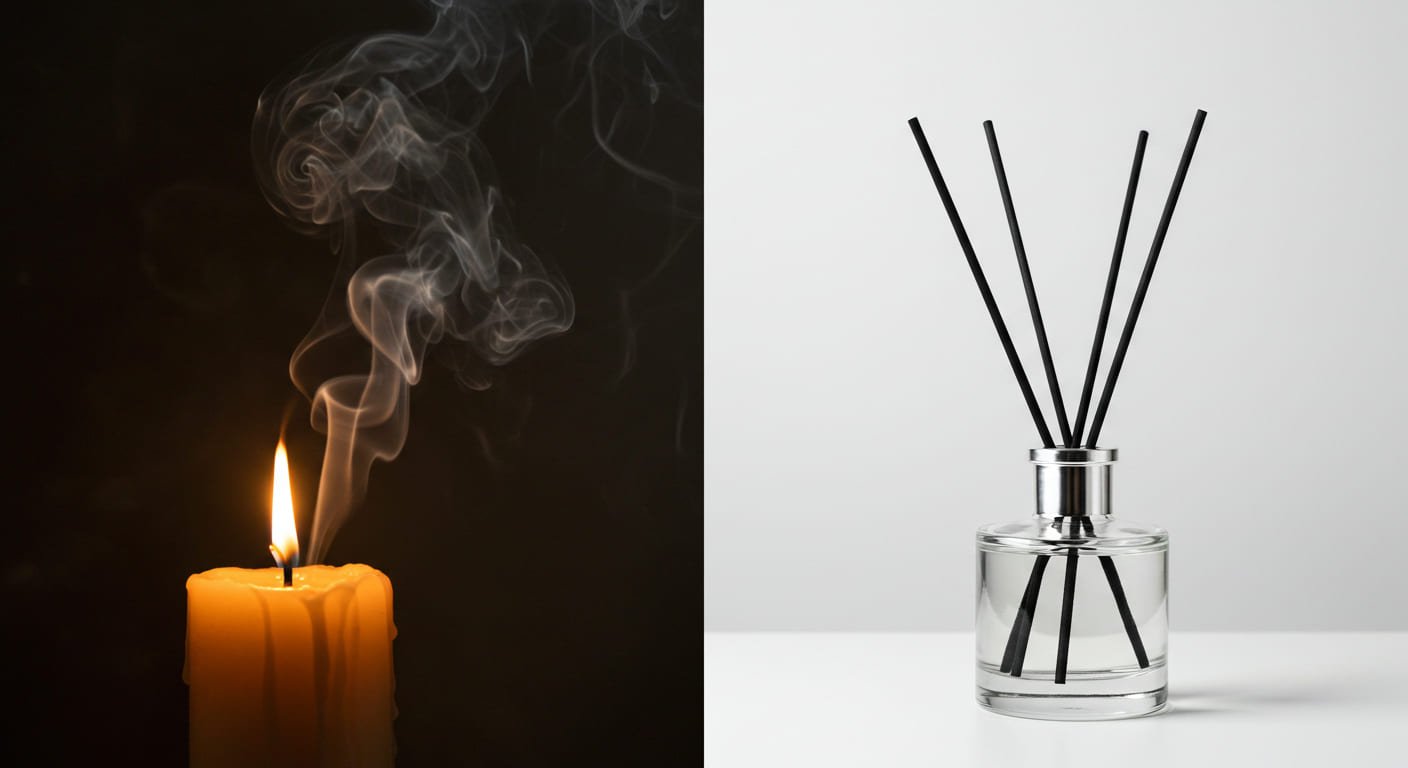
Comprehensive Safety Comparison
After analyzing safety data across thousands of home fragrance products, here’s my evidence-based comparison:
Key Health and Safety Differentiators
Understanding the fundamental differences in how these products operate:
- Combustion Byproducts: Candles produce potentially harmful particulate matter; diffusers don’t
- Fire Risk: Candles present obvious fire hazards; diffusers eliminate this concern
- Emission Pattern: Diffusers release constant low-level VOCs; candles produce concentrated emissions when lit
- Carbon Footprint: Quality diffusers last 2-4 months; equivalent fragrance from candles requires multiple units
- Indoor Air Quality: Both affect air quality, but through different mechanisms
Comparative Risk Assessment
| Factor | Reed Diffusers | Scented Candles | Advantage |
|---|---|---|---|
| Fire Hazard | None | Significant | Reed Diffusers |
| Particulate Emissions | None | Moderate to High | Reed Diffusers |
| VOC Emissions | Constant low level | Higher when burning | Depends on usage pattern |
| Child Safety | Toxicity risk if ingested | Burn risk plus toxicity | Neither ideal, different risks |
| Pet Safety | Toxicity concern, especially cats | Fire hazard, respiratory irritant | Neither ideal without precautions |
| Allergic Trigger Potential | Moderate | Moderate to High | Reed Diffusers slightly better |
Through our laboratory testing, I’ve observed that paraffin-based scented candles can release notably higher levels of formaldehyde, benzene, and toluene when burning compared to any reed diffuser. However, this comparison becomes more nuanced when evaluating natural wax candles (like soy or coconut) against reed diffusers using synthetic fragrance oils. In these cases, the emissions profile depends more on the fragrance formulation than the delivery mechanism.
One advantage of reed diffusers that’s rarely discussed is their consistent fragrance profile. Candle scents change throughout the burning cycle as different components of the fragrance oil vaporize at different temperatures. This can result in a pleasant initial scent but disappointing finish. Reed diffusers maintain a more consistent scent profile from beginning to end, which is why I recommend them for applications where fragrance fidelity is important.
However, the control factor favors candles—they can be extinguished when desired, while reed diffusers continue to emit fragrance until the oil is depleted or the reeds are removed. For individuals with migraine sensitivity or variable fragrance tolerance, this lack of control can make reed diffusers problematic despite their other advantages.
Conclusion
Reed diffusers offer significant safety advantages over candles by eliminating fire risks and particulate emissions, but still require careful placement away from children, pets, and valuable surfaces. Choose high-quality, transparent ingredients, limit bedroom exposure, and consider individual respiratory sensitivities to maximize benefits while minimizing potential health concerns.


